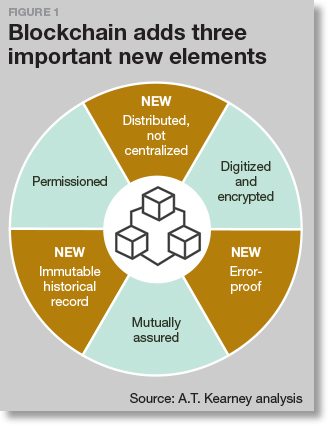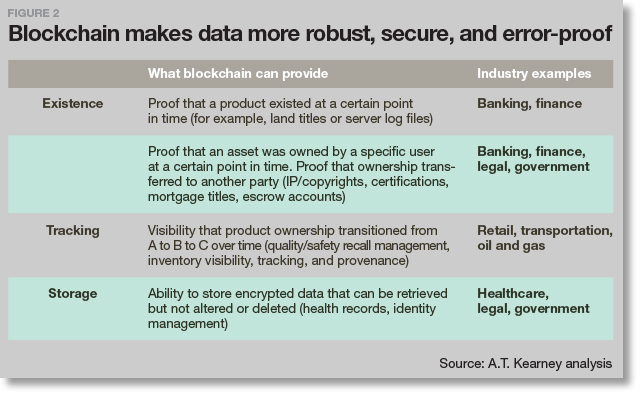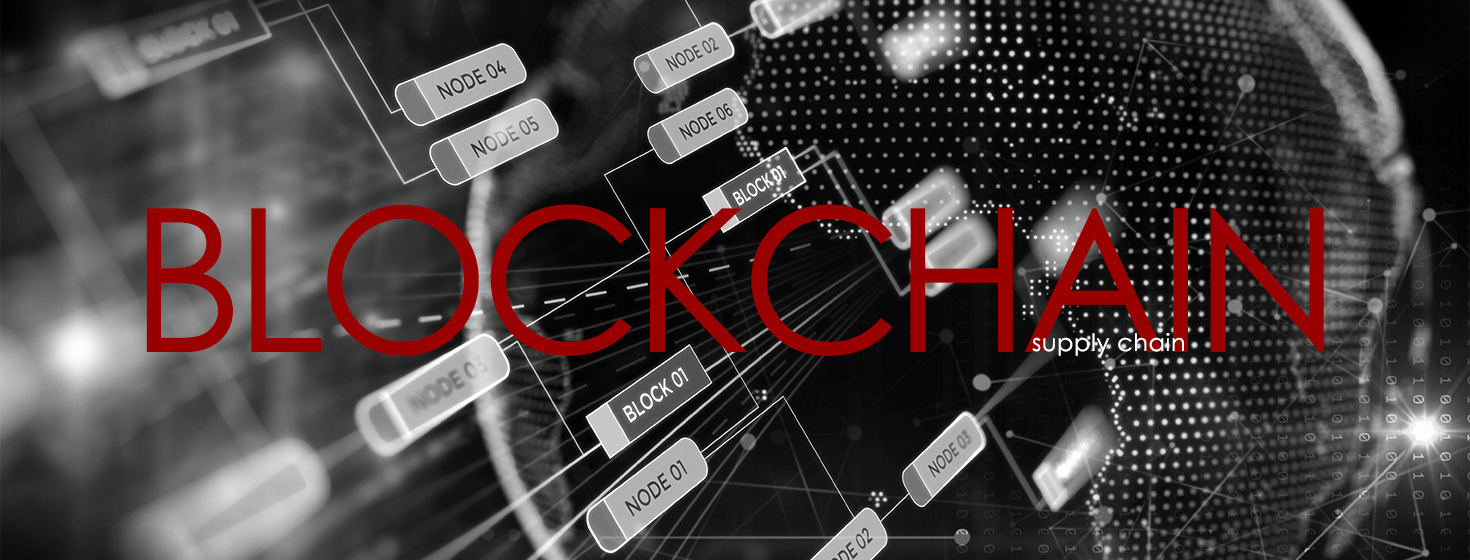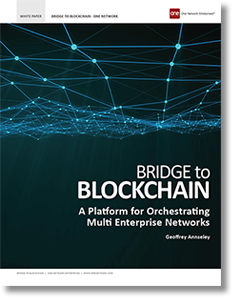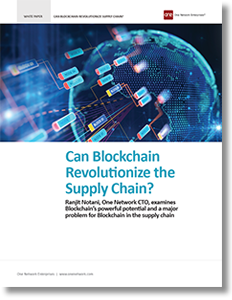Unlocking Blockchain’s Potential in Your Supply Chain

A.T. Kearney industry experts provide insights into blockchain's supply chain potential, and why, beneath all the hype, blockchain is a maturing technology that offers great promise.
A.T. Kearney’s Blockchain Insights
Blockchain has recently gained notoriety as the underlying technology behind the rise of bitcoin and other cryptocurrencies.
However, its true value is far greater, with the potential to fundamentally change the nature of any transaction that requires trust and verification in industries from retail, banking/finance and government to healthcare, transportation and oil and gas.
Proponents say blockchain will lower costs, improve planning and strengthen brand reputations.
Opponents say the technology is overhyped and not as efficient as traditional processes.
A.T. Kearney’s view? We see blockchain as a nascent technology that is still maturing but offers great promise in driving efficiencies in your supply chain.
Blockchain: A Ledger Innovation
Ledgers have been at the heart of every economic transaction since ancient times. From the first clay tablet that recorded characteristics of contracts, deeds, and purchases to today’s high-speed computers, companies rely on accurate, secure and reliable data.
The Blockchain is a ledger innovation that can make your data more robust, secure and error proof.
At its core, blockchain technology is a “distributed ledger,” with each ledger representing a “chain of blocks” containing data from multiple transactions, such as asset characteristics, price, date, and parties involved.
Blocks are continuously linked to each other forming a chain that is a complete historical list of all transactions. This ledger is continually shared and reconciled by all members. Because the records are stored by many keepers and available for all authorized users to see, it is auditable and verifiable.
Figure 1 highlights how blockchain enhances the characteristics of any current database system. The light blue blocks indicate the features common to all databases:
- permissioned access that can be restricted based on need;
- digitized information with heavy-duty encryption and highly secure technology; and
- mutually assured trust and validation to ensure security and accuracy of data.
Blockchain adds three important new elements, shown here as brown blocks:
- distributed, not centralized - there is no single point of failure or ownership;
- error-proof; the ability to encode “smart contracts” prevents accidental and/or intentional entry of transactions that violate contract terms; and
- an immutable historical record of every transaction that has ever occurred - the entries are permanent; therefore, changes are easier to track.
The result is a digitized recordkeeping platform that is auditable, decentralized, unchangeable and secure. Redundant systems are reduced and end-to-end information visibility allows for faster and more systematic root cause analysis.
The elimination of third parties can provide tremendous cost savings and complexity reduction opportunities. The transparent record of information can reduce fraud and security risk, and the decentralized storage of data makes it more secure.
While centralized ledgers are prone to cyber-attack, distributed ledgers are inherently harder to breach because all the distributed copies need to be attacked simultaneously for success. Further, these records are resistant to malicious changes by a single party.
Blockchain Can Transform Industries
Blockchain is capable of transforming current supply chain models while reducing costs. Its four archetypal uses include existence, ownership, tracking, and storage.
Relevant use cases in supply chains have been piloted in food, apparel, and luxury goods, notably around traceability and tracking.
Walmart’s success in tracing food sources using blockchain has sparked commitment from other major players. Food fraud and food-borne illnesses are major risks in the supply chain. IBM’s blockchain technology was piloted to track Mexican mangoes and Chinese pork. This trial involved farms, packing houses, brokers, warehouses and processing facilities and has greatly increased ingredient source tracking. Time to trace a source was reduced from days to minutes. As a result, Unilever, Nestlé, and Dole are committing to blockchain food source tracing for products including chicken, chocolate, and bananas. In addition, Walmart is seeking to apply blockchain technology to other areas of its business including package delivery.
Carrefour is using blockchain to trace the source of poultry with the goal to expand to other perishables including eggs, cheese, oranges, and salmon. For poultry, data is captured at each step from the hatchery, producer, and processor and gives consumers full product journey information. Consumers scan the QR code at retail to access product information. Not only does this enhance traceability from a food safety standpoint, it can enable retailers to tell much richer “farm-to-fork” stories to their customers.
Read: How Blockchain Could Transform Food Safety
Everledger has created a decentralized ledger used to track the origin and ownership of diamonds. Its purpose is to provide supply chain users (diamond manufacturers, primary and secondary retailers, consumers, insurance agencies and law enforcement) proof of origin and confidence in the provenance of conflict-free diamonds.
In addition, companies are exploring blockchain advantages in facilitating payments, post-purchase engagement and enhancing luxury ownership. Blockchain solutions will continue to gain traction in industries where they can successfully drive cost and efficiencies; deliver quality and service; and delight and empower consumers.
Understanding the Supply Chain’s Potential
With the tremendous hype around blockchain, it’s difficult to know if it is right for your organization.
Do you need blockchain to create high ROI wins or allow you to remain competitive? Or, do you want to embrace blockchain to elevate your customers’ experiences to gain a competitive advantage?
Actuating blockchain technology within your supply chain requires an enterprise commitment to assess your current business needs, design the appropriate solution and implement this new technology.
In the assessment phase, supply chain management must first identify a valid need for a blockchain solution such as: new paradigms for consumer lifecycle engagement or new models for 1:1 marketing; upgrades in speed, cost and quality and a more frictionless engagement with vendors; or, improvements in data storage and transaction processing or improved record keeping.
Blockchain technology is being applied in various industries at different speeds. For example, Walmart’s participation in the Blockchain Food Safety Alliance is a strong signal to other food and apparel manufacturers and retailers to build business cases for this technology.
Once the opportunities have been identified, internal capabilities need to be assessed prior to design and implementation. A partnership with a current blockchain provider may provide the enabling technologies to build a digital platform and implement a pilot. A pilot program can validate the business case and the ROI for expansion while identifying any additional barriers to success.
Combining blockchain technology with AI and IoT capabilities can provide exponentially greater benefit by reducing the possibility of error in data capture, and by accelerating decision-making based on transaction information.
Read: AI & Blockchain - An Introduction
In certain industries where the landscape is evolving quickly and blockchain is already having an impact, supply chain management will need to explore this technology to remain competitive. In other industries where the costs and risks currently outweigh the benefits, adopting a wait and see attitude may be appropriate. But, a wait-and-see attitude does not mean doing anything.
Read: Why Blockchain in the Supply Chain Is an Absolute Game Changer
Supply chain professionals need to stay informed and gain first-mover advantage by evaluating the benefits of blockchain especially across enterprises where there is an exponential value of real-time data, multiple handoffs, and a need for flexibility. This can be particularly valuable in industries with risk-laden products including pharmaceuticals, defense or safety. Early engagement and understanding the value of blockchain is the key to unlocking the full potential of this new technology.
About the Authors
Suketu Gandhi is a partner at A.T. Kearney, based in Chicago. Adrish Majumdar is a principal at A.T. Kearney, based in New York. Sean Monahan is a partner and global practice leader of A.T. Kearney’s Operations & Performance Transformation practice, based in New York. They can be reached at [email protected], [email protected], and [email protected].
Related Article: Blockchain Technology and the Real-Time Global Supply Chain
Related Blockchain White Papers
Bridge to Blockchain: A Platform for Orchestrating Multi-Enterprise Networks New!
In this white paper, you will learn why blockchain platforms vary widely in terms capability, disclosure, confidentiality, anonymity, the cost to use, and speed, and why companies need to leverage more than one blockchain network to realize game-changing business models. Download Now!
Can Blockchain Revolutionize the Supply Chain?
In this white paper Ranjit Notani, One Network CTO examines Blockchain’s powerful potential as well as a major problem and whether and how Blockchains can revolutionize the Supply Chain. Download Now!
More Resources on Blockchain
Article Topics
One Network Enterprises News & Resources
Blue Yonder announces an agreement to acquire One Network Enterprises for $839 million Blue Yonder Acquires One Network Enterprises for $839M Companies Need to Develop New Innovative Approaches to Supply Chain Design How to Improve Cost of Goods Sold Horizontally Across the Supply Chain How the Global Pandemic Accelerated Supply Chain Visibility, Digitalization, and Automation AI and Data, the Future of Supply Chain Management AI and Supply Chain Problem Solving More One Network EnterprisesLatest in Technology
Spotlight Startup: Cart.com is Reimagining Logistics Walmart and Swisslog Expand Partnership with New Texas Facility Taking Stock of Today’s Robotics Market and What the Future Holds Biden Gives Samsung $6.4 Billion For Texas Semiconductor Plants Apple Overtaken as World’s Largest Phone Seller Walmart Unleashes Autonomous Lift Trucks at Four High-Tech DCs Talking Supply Chain: Procurement and the AI revolution More Technology

